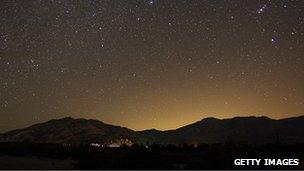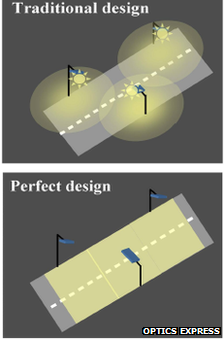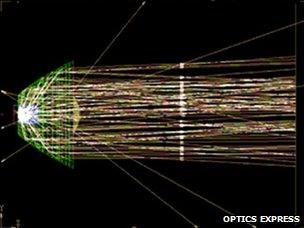LED streetlamp aims to improve public's view of stars
- Published

Light pollution prevents nearby residents from being able to see many of the stars in the night sky
Researchers believe they have come up with a new type of LED-powered streetlamp that could radically reduce light pollution.
Current designs "leak" large amounts of light in unwanted directions, obscuring views of the stars, wasting energy and making it harder for drivers to see.
The team, based in Mexico and Japan, said they believed their solution was the "best ever reported".
However, they have yet to turn their theory into a working prototype.
The study - carried out by scientists in Mexico and Taiwan - appears in the open-access journal Optics Express, external.
LED lens
According to the researchers, conventional street lamps - which use high-pressure sodium or mercury vapour - scatter up to 20% of their energy horizontally or vertically because it is difficult to control their beams.
It is easier to direct light from LEDs because it is being emitted from a smaller area.
So, while manufacturers controlled the direction of the light rays from older lamps using a reflector typically made out of polished aluminium, they can now take advantage of lenses to be more precise.
The researchers say the best LED (light-emitting diode) streetlamps on the market direct about 10% of their energy horizontally or vertically.
But they claim their own invention could further reduce the amount to just 2%.
Their proposed lamp uses three features to ensure the vast majority of its light is limited to a pre-determined rectangular shape covering the road:

The new lamp aims to better limit the light rays to where they are of use
A special "total internal reflection" lens for each LED designed to focus its light's rays so that they travel parallel to each other in a single direction. This is rather than criss-crossing and diverging from each other causing many to spill beyond the target area.
A reflecting cavity into which the lens-covered LEDs are fitted. This helps "recycle" any light rays which fail to travel the desired path.
A diffuser through which the focused light passes to help tackle unwanted glare.
The researchers suggest that the set-up would also save on electricity costs since it should require between 10 and 50% less power to illuminate a section of road than current LED streetlamps.
They added that they were now working to build a prototype and hoped to have it completed by October.
LED revolution
London-based light design firm Speirs and Major unveiled an LED-based streetlamp design, external of its own last year.
The firm's associate director, Andrew Howis, said the latest study was just one of several efforts under way aimed at tackling the problem of stray light.
"As a result of LEDs it is now possible to place light exactly where it is needed and to greatly reduce spill light and energy wastage," he said.
"This new research is an example of the innovation in LED optics - of which there are many - which uses a fairly sophisticated optical system to produce an optimised distribution for street lighting.
"It sounds like an advance on what is already available, but of itself is not revolutionary. The change from conventional light sources to LED is the revolution."
The Campaign to Protect Rural England (CPRE) also gave the new work a qualified welcome.

The lamp uses a special lens to focus most of the LED's rays so that they travel in parallel direction
The lobby group carries out an annual star count, external to publicise the problem of light pollution which it says disrupts wildlife and people's sleep.
It noted that the new technology would only be of use if councils were willing to invest in it.
"From 1993 to 2000, light pollution in England increased by 26%, which shows the huge amount of energy and money wasted," said campaigner Emma Marrington.
"It should be seen as an investment for local authorities to install more efficient street lighting, which will save money and energy waste in the long-term.
"Design is great but councils have to follow through with investment."
- Published11 April 2013